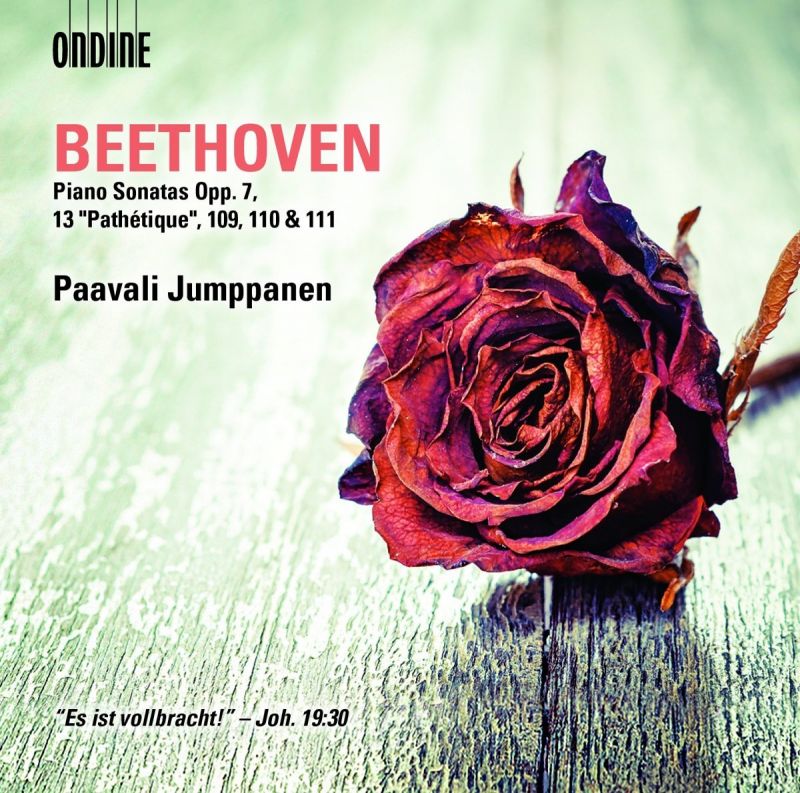BEETHOVEN Piano Sonatas Nos 7, 13, 109-111
View record and artist detailsRecord and Artist Details
Composer or Director: Ludwig van Beethoven
Genre:
Instrumental
Label: Ondine
Magazine Review Date: 01/2017
Media Format: CD or Download
Media Runtime: 118
Mastering:
DDD
Catalogue Number: ODE1298-2D

Tracks:
| Composition | Artist Credit |
|---|---|
| Sonata for Piano No. 4 |
Ludwig van Beethoven, Composer
Ludwig van Beethoven, Composer Paavali Jumppanen, Piano |
| Sonata for Piano No. 8, 'Pathétique' |
Ludwig van Beethoven, Composer
Ludwig van Beethoven, Composer Paavali Jumppanen, Piano |
| Sonata for Piano No. 30 |
Ludwig van Beethoven, Composer
Ludwig van Beethoven, Composer Paavali Jumppanen, Piano |
| Sonata for Piano No. 31 |
Ludwig van Beethoven, Composer
Ludwig van Beethoven, Composer Paavali Jumppanen, Piano |
| Sonata for Piano No. 32 |
Ludwig van Beethoven, Composer
Ludwig van Beethoven, Composer Paavali Jumppanen, Piano |
Author: Jed Distler
He unfolds the Pathétique’s Grave introduction at a daringly slow and steady pace. If the main body of the movement is not quite Allegro di molto, animation is still suggested by way of Jumppanen’s clear lines and attention to accents. The central Adagio starts out slow and austere but eventually gains speed and flexibility, in contrast with Jumppanen’s slightly square, held-back Rondo finale.
The rhapsodic Vivace ma non troppo of Op 109 is a model of sensitive phrasing and timing, in spite of Jumppanen’s downplaying the climaxes (here Igor Levit and Paul Lewis give their all). The Prestissimo makes up in linear tension for what it lacks in fervency. I was surprised by much of the variation movement’s detachment and reserve, compared to Jumppanen’s far more fluent and involving live performance from the Isabella Stewart Gardiner Museum (available free online). Although more songful and mellifluous Op 110 interpretations grace the catalogue (Angela Hewitt’s, for example, among recent recordings – Hyperion, 9/15), Jumppanen’s ability to clarify the busiest, thickest fugal writing without sacrificing tonal heft must be acknowledged.
In Op 111’s first movement, Jumppanen revels in the transitional episodes’ emotional ambiguity but his accurate yet notey execution of the rapid counterpoint doesn’t match Pollini or Arrau for power and sheen. The pianist brings riveting breadth to the Arietta theme and the first variation but his slight speeding-up for the following two variations somehow breaks the spell. Towards the end, many pianists primarily focus on the long chains of trills, while Jumppanen gives equal and welcome due to the left hand’s changing harmonies.
In sum, a superbly engineered and annotated conclusion to a Beethoven cycle characterised by occasional drawbacks and numerous strengths.
Discover the world's largest classical music catalogue with Presto Music.

Gramophone Digital Club
- Digital Edition
- Digital Archive
- Reviews Database
- Full website access
From £8.75 / month
Subscribe
Gramophone Full Club
- Print Edition
- Digital Edition
- Digital Archive
- Reviews Database
- Full website access
From £11.00 / month
Subscribe
If you are a library, university or other organisation that would be interested in an institutional subscription to Gramophone please click here for further information.




